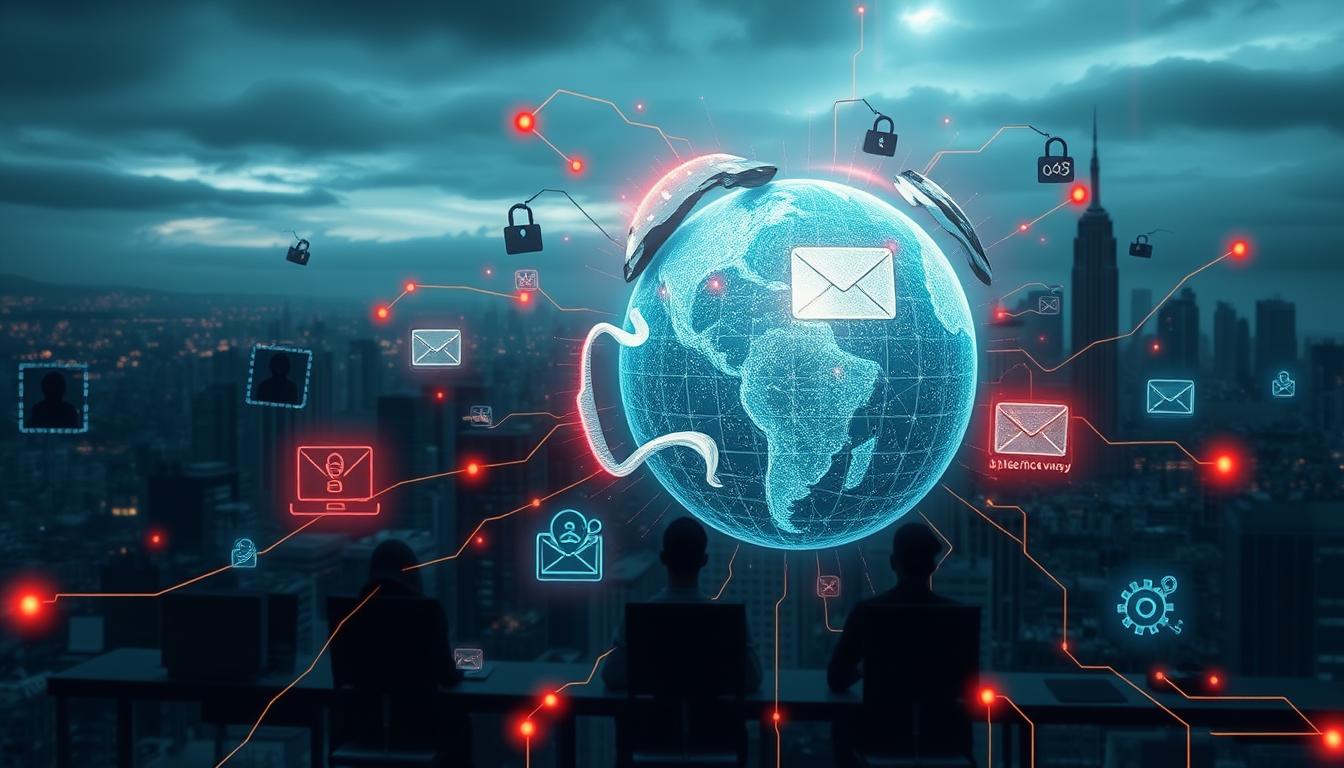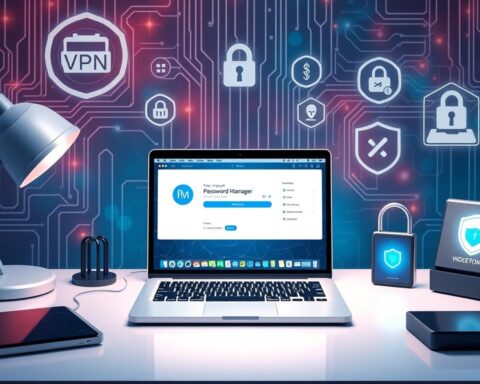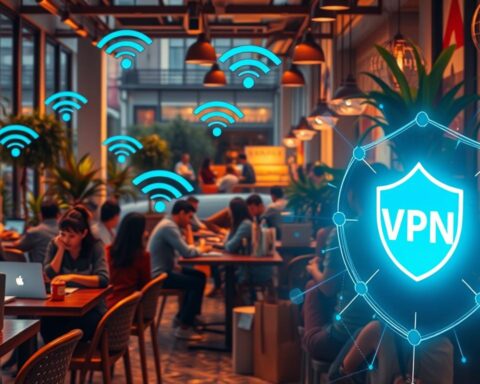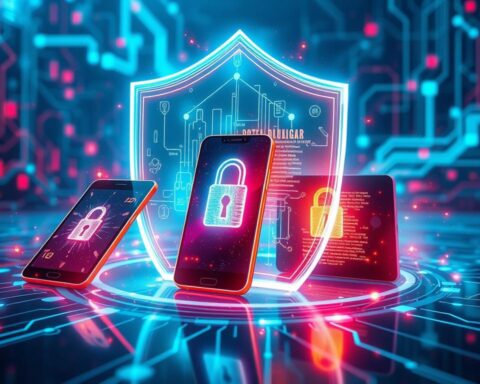In 2023, a huge 38 terabytes of private data were leaked by Microsoft AI researchers. This happened because of a simple mistake. It shows how big the damage can be from small security mistakes1.
This event is a clear sign of how important strong cybersecurity is today. Our world is more digital than ever before.
We will look at real cyber attacks and what we can learn from them. These stories are very useful for any company. They teach us about data breaches and ransomware attacks. These are big challenges for businesses in many fields.
They show us why we need to be ready for security problems. We also need to know how to handle them when they happen.
The world of cyber threats is changing fast. Ransomware is now a big threat to homes, businesses, and government networks2. This deep dive will give you key info on managing cyber attacks. You’ll learn from the basics to advanced ways to keep your security strong.
Key Takeaways
- Cybersecurity incidents can result from various causes, including insider negligence and malicious intent
- Social engineering attacks account for a significant portion of data breaches and cybersecurity incidents
- Misconfigured databases and systems can lead to massive data exposures
- Ransomware poses a critical threat to networks and critical infrastructure
- Proper training and awareness are key to preventing and responding to cyber incidents
Understanding Cyber Incident Management Fundamentals
Cyber incident management is key for companies to deal with cyber attacks. The world of digital threats keeps changing. So, businesses must stay ahead of these risks.
Defining Cyber Incident Management vs Incident Response
Cyber Incident Management (IM) is more than just Incident Response (IR). It focuses on big incidents that overwhelm Security Operations Centers (SOC)3. It needs teamwork with both inside and outside partners to handle big cyber issues well3. Companies with good incident management can save a lot on data breaches, up to $473,706 on average4.
Role of Incident Management Teams
Incident management teams are key in handling big cyber attacks. They need strong leaders, as many team members may not have dealt with big incidents before3. Training in incident response is important for better security handling and posture5. Companies that focus on incident response see a 50% drop in successful attacks after training5.
Business Impact Assessment
Doing a deep business impact assessment is key for making decisions in cyber crises. Companies that set clear severity levels for incidents can respond faster and focus on the most critical threats5. A structured approach to incident handling makes responses smoother, with downtimes cut by up to 40%5. These gains show the importance of learning from past cyber attacks and using those lessons to boost cyber security.
Historical Overview of Major Cyber Attacks
The digital world has seen a big increase in cyber threats in the last ten years. This change has made us rethink how we handle cyber attacks and protect our data. Let’s look at the key moments in cyber history and how they’ve shaped our security efforts.
Evolution of Cyber Threats
Cyber attacks have become more complex and widespread. In 2011, Sony’s PlayStation Network was hit hard, exposing 77 million users’ data and shutting down for 23 days6. By 2013, attacks had gotten even bigger, with Adobe facing a breach that affected 38 million users and stole 40 GB of source code6.
Impact on Global Security Landscape
These big breaches have led to major changes in how we protect ourselves online. The 2013 Target breach, which hit 110 million customers, made Target spend $100 million on better security67. The 2019 SolarWinds attack showed us how important it is to keep our supply chains safe7.
Timeline of Significant Breaches
| Year | Incident | Impact |
|---|---|---|
| 2013 | Yahoo | 3 billion accounts exposed8 |
| 2016 | Uber | 57 million users affected7 |
| 2021 | Microsoft Exchange | 60,000 companies impacted globally8 |
In 2021, the US saw a record 1862 data breaches, a 68% jump from 20208. These numbers show how urgent it is to have strong plans for dealing with cyber attacks and to keep improving our security measures.
Case Studies: Real-World Cyber Incidents and Key Takeaways
Looking at real cyber attacks gives us key insights into the world of cybersecurity. These examples show how vital it is to have strong cyber defenses. They also stress the need to keep improving our security measures.
Target Data Breach
The 2013 Target data breach was a big wake-up call for cybersecurity. It affected over 41 million customers, causing a huge stir in the retail world9. The breach showed us how important it is to manage third-party vendors well and use strong network segmentation.
Equifax Security Incident
In 2017, Equifax had a huge data breach, affecting about 147 million people109. It happened because of a weakness in Equifax’s website. This showed us how vital it is to patch up weaknesses quickly and have good data management.
Colonial Pipeline Ransomware Attack
The 2021 Colonial Pipeline ransomware attack showed us how vulnerable critical infrastructure is. It caused big fuel shortages and showed how cyber attacks can disrupt our lives. It’s a clear sign we need strong cybersecurity for essential services.
SolarWinds Supply Chain Compromise
The 2020 SolarWinds breach affected thousands, including government agencies and big companies10. It was a complex attack that showed us how important it is to secure third-party software. It also stressed the need for good vendor management to avoid risks from outside sources10.
These examples teach us about the changing cyber threats and the need to stay alert. They highlight the value of regular security checks, quick patching, and training employees. By learning from these incidents, companies can get ready for and handle future cyber threats better.
Critical Infrastructure Protection Strategies
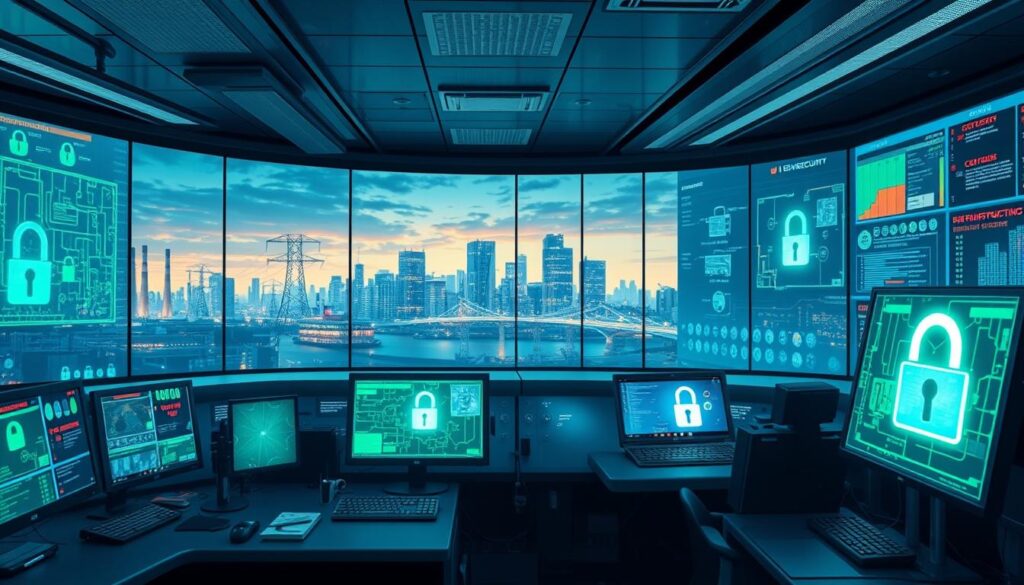
The world’s critical systems are now more connected than ever. This has made them vulnerable to cyber attacks. With over 46 billion devices connected in 2021, this number is expected to grow fast11. It’s vital to have strong protection plans to keep these systems safe from cyber threats.
Cyber attacks on critical infrastructure are becoming more common. The 2021 Colonial Pipeline attack caused big fuel problems on the East Coast of the U.S12.. In 2015, Ukraine’s power grid was hit, leaving 225,000 people without power for six hours13.
To fight these threats, we need to act. Here are some steps to take:
- Regularly check for vulnerabilities and test systems
- Follow rules like NIST and ISO 27001
- Update old systems and apply security patches
- Train employees to avoid mistakes, as most breaches come from human error11
Malware-as-a-service has made it easier for hackers to target us11. With cyber attacks on the rise, we must be proactive about security.
| Sector | Key Vulnerabilities | Protection Strategies |
|---|---|---|
| Energy | Legacy systems, interconnected grids | SCADA security, network segmentation |
| Healthcare | IoT devices, patient data | Device security, data encryption |
| Transportation | Connected vehicles, traffic systems | Secure communication protocols, AI-based threat detection |
| Finance | Online transactions, customer data | Multi-factor authentication, blockchain technology |
By using these strategies and staying alert, we can better protect our critical systems. Keeping these systems safe is key to our national security and economic health in today’s digital world.
Cloud Security Breach Prevention
Cloud security is now a top concern in our digital world. As more businesses shift to the cloud, the risk of data breaches increases. This section looks at ways to stop cloud security breaches, using lessons from real cybercrime cases.
Cloud Configuration Best Practices
Setting up cloud security right is key to avoiding breaches. The 2019 Capital One data breach showed how important strong cloud security is14. To stay safe, companies should:
- Regularly check their cloud setups
- Have strong access controls
- Encrypt sensitive data
- Watch for any odd cloud activity
Access Control Management
Good access control is vital for cloud security. It’s important to only give users the access they need. Adding extra security steps, like multi-factor authentication, helps a lot too.
Data Protection in Cloud Environments
Keeping data safe in the cloud needs a few steps. The 2023 MOVEit breach showed the damage of poor data protection15. To better protect data:
- Encrypt data when it’s stored and moving
- Use data classification systems
- Do regular security checks
- Have plans ready for when something goes wrong
Learning from past mistakes is key to better cloud security. The 2017 Equifax breach was caused by not fixing a web app vulnerability16. This shows how important it is to keep software up to date.
| Security Measure | Description | Impact |
|---|---|---|
| Regular Audits | Periodic review of cloud configurations and security settings | Identifies vulnerabilities before they can be exploited |
| Multi-Factor Authentication | Requires multiple forms of verification for access | Significantly reduces unauthorized access attempts |
| Data Encryption | Protecting data at rest and in transit | Ensures data remains unreadable if intercepted |
By following these cloud security tips and learning from past mistakes, companies can lower their risk of data breaches. Always keep improving and stay alert to keep your cloud data safe.
Ransomware Response and Recovery
Ransomware attacks are a big threat to companies all over the world. They can cause a lot of damage, like the Colonial Pipeline attack. This section will talk about how to deal with and get over ransomware attacks. We’ll focus on keeping your systems safe and reducing risks.
Initial Containment Steps
Act fast when you get hit by ransomware. First, cut off infected systems to stop it from spreading. Turn off network connections and Wi-Fi on devices that got hit. Make sure to save evidence for later by creating images of the affected systems.
Then, tell your incident response team and start your cyber resilience plan. If it’s really bad, think about getting help from outside cybersecurity experts.
Negotiation Considerations
Deciding to talk to the attackers is hard. Some companies have paid, but it’s not always the best choice. Ransom demands can be huge, sometimes up to $80 million17. Think about these things:
- Legal issues of paying ransoms
- Chances of getting your data back
- Risk of getting hit again
- How it will affect your company’s money
In 2021, a big pipeline company paid $4.4 million in ransom18. But, paying doesn’t mean you’ll get all your data back or stop future attacks.
System Restoration Protocols
Having good plans for fixing systems is key for staying safe online. First, figure out how bad the damage is and fix the most important systems first. Use safe, offline backups to get your systems and data back.
Before you start fixing things, make sure your systems are free of malware. Learn from past attacks by scanning and patching systems before you connect them to the network again.
| Recovery Step | Description |
|---|---|
| Assess Damage | Find out what systems and data are affected |
| Prioritize Recovery | Focus on fixing what’s most important for your business |
| Clean Systems | Get rid of malware and fix vulnerabilities |
| Restore Data | Use safe backups to put back clean data |
| Test and Verify | Make sure systems are working right and are safe |
By following these steps and using strong cybersecurity, companies can fight off ransomware better. This helps keep damage low.
Supply Chain Security Management
Supply chain security is now a top concern in cybersecurity. Recent cyber attacks have shown how damaging they can be. The SolarWinds breach in 2020 is a prime example, hitting many government agencies and big companies.
Supply chain attacks have jumped by 78% in recent years. In the last 12 months, 97% of firms have seen negative effects from these breaches19. This shows we need strong strategies for managing supply chain security.
Managing supply chain risks is a big challenge for organizations. A surprising 77% of companies don’t have enough data to understand their risks19. This lack of knowledge makes them vulnerable to cyber attacks.
The manufacturing sector has been hit hard by these attacks. In 2023, it was the third-most targeted by ransomware and the fourth by business email compromise20. The average cost of a ransomware attack in manufacturing is $500,000 USD20.
Here are some examples of the financial damage from supply chain breaches:
- Clorox lost $356 million USD due to disruptions, including a 20% drop in sales.
- Norsk Hydro’s ransomware attack cost them $70 million USD.
- The NotPetya attack cost companies like Maersk and FedEx $700 million USD20.
To fight these risks, companies need to take steps. They should do regular risk assessments, improve their cybersecurity, and spread out their suppliers. Using new tech like AI and blockchain can help detect threats and lower risks21.
As we connect more devices, with 29 billion expected by 2030, keeping our supply chains safe is key20. By learning from past attacks and using strong security, companies can protect themselves from future threats.
Incident Communication Protocols
When big data breaches and cyber attacks happen, talking clearly is key. Companies need strong plans to handle what people say, the public, and rules from regulators.
Stakeholder Communication Strategy
Having a solid plan for talking to stakeholders is essential. The 2017 Equifax breach showed how important it is to be open and quick with information10. It’s important to send out clear messages to everyone involved.
Public Relations Management
Handling public relations after a cyber attack is tough. The 2019 Capital One breach showed the need for fast and honest updates10. Companies must find a balance between being open and following the law to keep trust.
Regulatory Notification Requirements
Following rules about telling people about breaches is a must. Uber was fined $148 million for not telling about a breach fast enough22. Companies need to know their legal duties and act quickly to avoid big fines.
| Incident Type | Communication Focus | Key Stakeholders |
|---|---|---|
| Data Breach | Scope of breach, affected data | Customers, regulators, media |
| Ransomware Attack | Service disruptions, recovery plans | Employees, partners, clients |
| Supply Chain Compromise | Impact assessment, mitigation steps | Vendors, clients, industry peers |
Good communication can really help a company recover from cyber attacks. Training employees can cut down on mistakes by up to 45% and speed up responses by about 30%22. These numbers show how important it is to have good plans for talking during cyber attacks.
Building Resilient Security Programs
In today’s digital world, building resilient security programs is key. Cyber threats are on the rise, and companies must protect their data and assets. They need strong strategies to do so.
Employee Training Frameworks
A solid employee training framework is essential. Companies should hold regular, engaging sessions. These should teach cybersecurity best practices and how to handle incidents.
After the CrowdStrike outage, 83% of companies said they had an incident response plan. And 76% said it worked well23.
Security Awareness Initiatives
It’s important to create a culture of security. Security awareness programs should teach employees about threats and their role in keeping things safe. Almost everything we use today relies on networked technologies, making cybersecurity awareness critical24.
Continuous Improvement Strategies
Organizations must keep improving to stay ahead of threats. This means regular checks, feedback, and quick responses to new risks. FEMA and CISA emphasize the need for both a cybersecurity program and a plan for handling incidents24.
| Component | Key Focus Areas | Benefits |
|---|---|---|
| Employee Training | Cybersecurity best practices, Incident response | Improved threat detection, Faster incident resolution |
| Security Awareness | Threat education, Role-based responsibilities | Enhanced organizational security culture |
| Continuous Improvement | Regular assessments, Agile response strategies | Adaptability to new threats, Increased resilience |
Companies should use tools like the Cyber Security Evaluation Tool (CSET) to check their security. The NIST Cybersecurity Framework helps create detailed security plans24.
By using these strategies, companies can build strong security programs. These programs can keep up with changing threats. Remember, security is a never-ending journey that needs constant effort and improvement.
Future Trends in Cybersecurity
The world of cybersecurity is changing fast, with new dangers and technologies popping up all the time. As companies try to stay safe online, it’s key to know what’s coming next. This helps them find the best ways to protect themselves.
Artificial Intelligence (AI) and Machine Learning (ML) are going to be big in both attacks and defenses. They can spot and stop threats, but bad guys can use them too. In 2024, data breaches cost companies an average of $4.88 million, showing how important strong security is25.
Zero-trust architecture is becoming a top choice for network safety. It doesn’t trust anyone by default, making sure everyone proves they’re okay before getting into a network. With 88% of breaches caused by people making mistakes, this approach can really help25.
The Internet of Things (IoT) and 5G networks bring both good and bad for cybersecurity. They make things more connected and data faster, but they also give hackers more chances to get in. In December 2022, IoT attacks hit over 10.54 million times, showing we need to be extra careful25.
“The future of cybersecurity lies in proactive defense and continuous adaptation to emerging threats.”
New laws and rules are also changing how we keep things safe online. Companies need to keep up with these changes to stay safe and follow the law. The Cybersecurity Assessment Tool (CAT) has three levels and twenty-five practices to help them stay ahead.
| Trend | Impact | Mitigation Strategy |
|---|---|---|
| AI and ML in Cybersecurity | Enhanced threat detection and response | Invest in AI-powered security tools |
| Zero-Trust Architecture | Improved access control and data protection | Implement strict authentication protocols |
| IoT and 5G Security | Expanded attack surface | Develop IoT-specific security measures |
| Evolving Regulations | Increased compliance requirements | Stay informed and adapt security practices |
As threats keep getting smarter, companies must focus on cybersecurity more than ever. By following the latest trends and using strong protection, businesses can keep their data safe in our digital world.
Conclusion
Looking at case studies and real-world cyber incidents teaches us a lot about keeping data safe. As cyber threats grow, companies face big challenges in guarding their data. The cost of these threats has jumped from $8.3 million in 2018 to $16.2 million in 2023, showing we need strong security inside26.
The Cash App breach, affecting 8.2 million customers, shows how fast we must act and be open when something goes wrong26. The NotPetya attack, which cost over $10 billion and hurt many sectors worldwide, warns us of the dangers of cyber attacks27. It teaches us the importance of quick fixes and good crisis plans.
To fight these threats, companies need to focus on solid cybersecurity plans. They should use strong access controls, check their security often, and train their employees. The CAT framework helps find and fix security gaps, making companies stronger. By learning from these incidents and being proactive, businesses can stay safe from cyber dangers.
FAQ
What is the difference between cyber incident management and incident response?
How have cyber threats evolved over time?
What were the key lessons learned from the Target data breach?
How can organizations protect their critical infrastructure from cyber attacks?
What are some best practices for cloud security?
How should organizations respond to a ransomware attack?
What strategies can be employed to enhance supply chain security?
What are the key components of an effective incident communication protocol?
How can organizations build a culture of cybersecurity awareness?
What emerging technologies are shaping the future of cybersecurity?
Source Links
- Top 10 Best-Known Cybersecurity Incidents and What to Learn from Them | Syteca – https://www.syteca.com/en/blog/top-10-best-known-cybersecurity-incidents-and-what-to-learn-from-them
- Incident Response Training | CISA – https://www.cisa.gov/resources-tools/programs/Incident-Response-Training
- LDR553: Cyber Incident Management™ – https://www.sans.org/cyber-security-courses/cyber-incident-management-training/
- What is Incident Response? | IBM – https://www.ibm.com/think/topics/incident-response
- Mastering Incident Response Training: Essential Tips for Effective Incident Management | dig8ital – https://dig8ital.com/post/incident-response-training/
- The Biggest Moments in Cybersecurity History (in the Past 10 Years) – https://www.digitalguardian.com/blog/biggest-moments-cybersecurity-history-past-10-years
- Case Studies: Notable Breaches | Codecademy – https://www.codecademy.com/article/case-studies-notable-breaches
- Biggest Data Breaches in US History (Updated 2025) | UpGuard – https://www.upguard.com/blog/biggest-data-breaches-us
- Case Studies on Cybersecurity Failures and Lessons – Morris McLane – https://morrismclane.com/case-studies-on-cybersecurity-failures-and-lessons/
- Case Studies on Software Security Breaches: Lessons from Major Incidents – https://www.linkedin.com/pulse/case-studies-software-security-breaches-lessons-from-joseph-biji-b6uef
- Incentives are key to breaking the cycle of cyberattacks on critical infrastructure – https://www2.deloitte.com/us/en/insights/industry/public-sector/cyberattack-critical-infrastructure-cybersecurity.html
- Cybersecurity in Critical Infrastructure: Protecting National Assets from Attacks – https://www.linkedin.com/pulse/cybersecurity-critical-infrastructure-iyfzf
- Cybersecurity for Critical Infrastructure: Addressing Threats and Vulnerabilities in Canada – https://bearworks.missouristate.edu/cgi/viewcontent.cgi?article=4364&context=theses
- Real-Life Examples: Lessons Learned from Major Cyber Breaches – https://www.datalinknetworks.net/dln_blog/real-life-examples-lessons-learned-from-major-cyber-breaches
- The Biggest Data Breaches of the Year (2024) – https://www.bluefin.com/bluefin-news/biggest-data-breaches-year-2024/
- Real-World Applications of Cybersecurity: Case Studies and Success Stories – https://www.webasha.com/blog/real-world-applications-of-cybersecurity-case-studies-and-success-stories
- 50 Examples of Ransomware Attacks and Their Impacts – https://www.digitalguardian.com/blog/50-examples-ransomware-attacks-and-their-impacts
- Real-life Ransomware Stories – https://www.macrosoftinc.com/real-life-ransomware-stories/
- How (and Why) Cyber Attacks are Exploiting the Supply Chain – NeoSystems LLC – https://www.neosystemscorp.com/blog/cyber-attacks-exploiting-the-supply-chain/
- Biggest Manufacturing Industry Cyber Attacks | Arctic Wolf – https://arcticwolf.com/resources/blog/top-8-manufacturing-industry-cyberattacks/
- Top 40 Cybersecurity Case Studies [Deep Analysis][Updated][2025] – https://digitaldefynd.com/IQ/cybersecurity-case-studies/
- Learnings from Cybersecurity Case Studies Analysis – https://www.nucamp.co/blog/coding-bootcamp-cybersecurity-learnings-from-cybersecurity-case-studies-analysis
- Lessons Learned from the CrowdStrike Outage: 5 Strategies to Build Cyber Resilience – https://www.aon.com/en/insights/articles/building-cyber-resilience-effectively-5-lessons?collection=3ab7b09b-e783-4c99-b960-0be73fb4fa49&parentUrl=/en/about/leadership-and-governance/assessment-solutions-sub-processors
- Planning Considerations for Cyber Incidents – https://www.fema.gov/sites/default/files/documents/fema_planning-considerations-cyber-incidents_2023.pdf
- 157 Cybersecurity Statistics and Trends [updated 2024] – https://www.varonis.com/blog/cybersecurity-statistics
- 7 Real-Life Data Breaches Caused by Insider Threats | Syteca – https://www.syteca.com/en/blog/real-life-examples-insider-threat-caused-breaches
- PDF – https://cyberpeaceinstitute.org/wp-content/uploads/wreckweb_single_page.pdf
